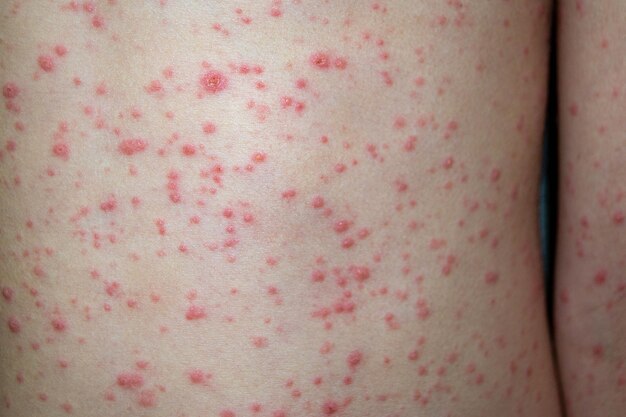Chickenpox, also known as varicella, is a highly contagious viral infection caused by the varicella-zoster virus (VZV). While chickenpox is most commonly associated with childhood, it can affect individuals of any age who have not been vaccinated or previously infected. Recognizing the signs and symptoms of chickenpox is crucial for prompt diagnosis, treatment, and prevention of transmission. Here’s a comprehensive guide to help you identify the signs of chickenpox:
- Characteristic Rash:
One of the hallmark signs of chickenpox is a characteristic rash consisting of small, red, itchy blisters that appear on the skin. The rash typically starts on the face, scalp, or trunk and then spreads to other parts of the body, including the arms, legs, and mucous membranes. - Red Spots (Macules):
The chickenpox rash often begins as red spots or macules that gradually develop into fluid-filled blisters over the course of several hours to days. These red spots may be accompanied by mild fever, headache, and general malaise. - Fluid-Filled Blisters (Vesicles):
As the chickenpox rash progresses, the red spots transform into fluid-filled blisters known as vesicles. These vesicles are typically small, round, and raised, with clear or cloudy fluid inside. The blisters may be intensely itchy and can vary in size and distribution. - Crusting and Scabbing:
After several days, the fluid-filled blisters begin to dry out and form crusts or scabs. The crusts may be yellowish or brownish in color and can be accompanied by mild pain or discomfort. Scratching the blisters can increase the risk of bacterial infection and scarring. - Multiple Stages of Rash:
During the course of chickenpox, multiple stages of the rash may be present simultaneously, with new lesions appearing while older lesions crust over and heal. This characteristic feature distinguishes chickenpox from other rash-causing conditions. - Fever and Malaise:
In addition to the rash, individuals with chickenpox may experience other symptoms such as fever, headache, fatigue, and loss of appetite. Fever is typically mild to moderate in severity but can occasionally be higher, especially in young children. - Respiratory Symptoms:
Some individuals with chickenpox may develop mild respiratory symptoms such as cough, sore throat, or runny nose. These symptoms are usually mild and may precede the appearance of the rash by a few days. - Contagiousness:
Chickenpox is highly contagious and can spread easily from person to person through respiratory droplets or direct contact with fluid from the blisters. Individuals with chickenpox are contagious from one to two days before the rash appears until all the blisters have crusted over. - Incubation Period:
The incubation period of chickenpox is typically 10 to 21 days after exposure to the virus, during which time individuals may be asymptomatic but still contagious. The onset of symptoms usually occurs within two to three weeks after exposure. - Complications:
While chickenpox is usually a mild and self-limiting illness, it can sometimes lead to complications, especially in certain high-risk groups such as infants, pregnant women, and individuals with weakened immune systems. Complications of chickenpox may include bacterial skin infections, pneumonia, encephalitis, and sepsis.
Recognizing the signs of chickenpox is essential for prompt diagnosis and appropriate management of the infection. If you suspect that you or someone you know has chickenpox, it’s important to seek medical attention for confirmation of the diagnosis and guidance on appropriate treatment and infection control measures. Vaccination against chickenpox is highly effective in preventing the disease and its complications, so be sure to follow recommended vaccination schedules to protect yourself and your loved ones.










